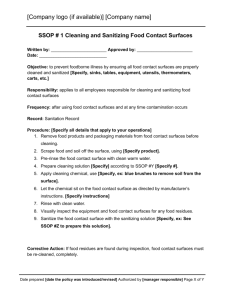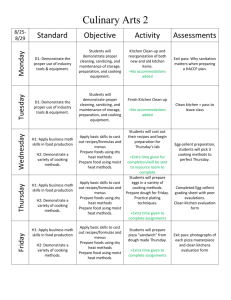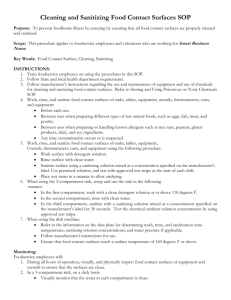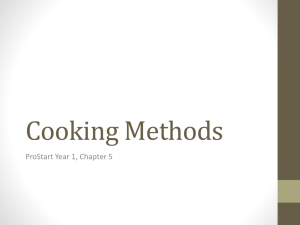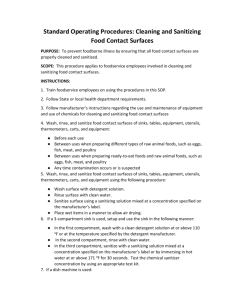Lesson 4-script - Family and Consumer Sciences
advertisement
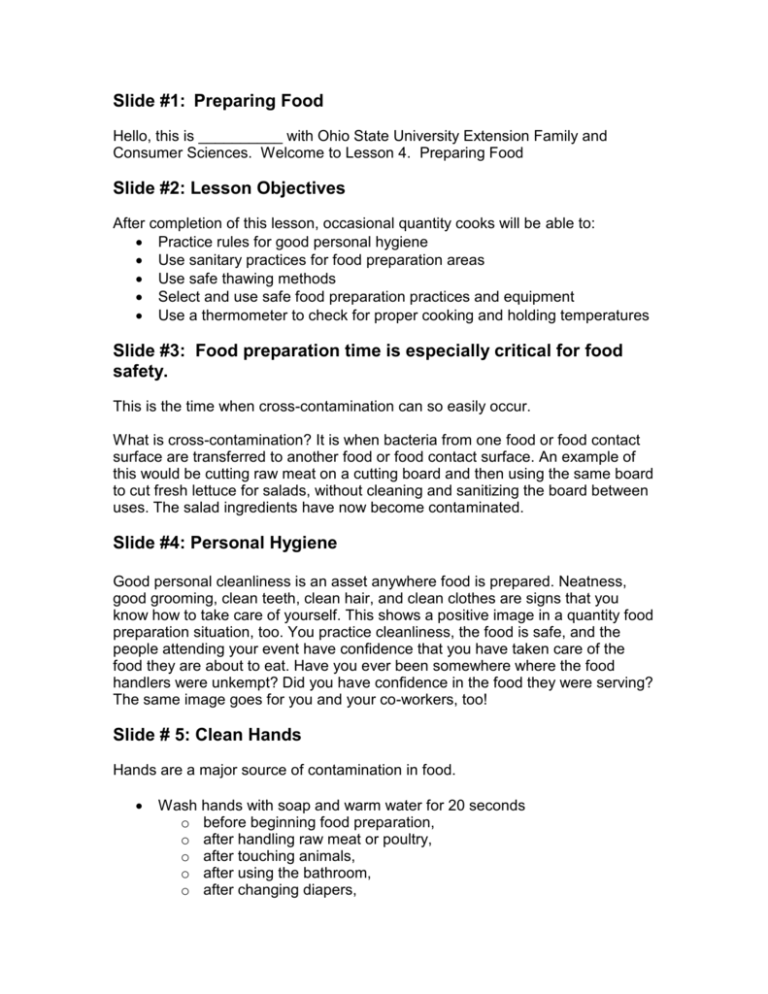
Slide #1: Preparing Food Hello, this is __________ with Ohio State University Extension Family and Consumer Sciences. Welcome to Lesson 4. Preparing Food Slide #2: Lesson Objectives After completion of this lesson, occasional quantity cooks will be able to: Practice rules for good personal hygiene Use sanitary practices for food preparation areas Use safe thawing methods Select and use safe food preparation practices and equipment Use a thermometer to check for proper cooking and holding temperatures Slide #3: Food preparation time is especially critical for food safety. This is the time when cross-contamination can so easily occur. What is cross-contamination? It is when bacteria from one food or food contact surface are transferred to another food or food contact surface. An example of this would be cutting raw meat on a cutting board and then using the same board to cut fresh lettuce for salads, without cleaning and sanitizing the board between uses. The salad ingredients have now become contaminated. Slide #4: Personal Hygiene Good personal cleanliness is an asset anywhere food is prepared. Neatness, good grooming, clean teeth, clean hair, and clean clothes are signs that you know how to take care of yourself. This shows a positive image in a quantity food preparation situation, too. You practice cleanliness, the food is safe, and the people attending your event have confidence that you have taken care of the food they are about to eat. Have you ever been somewhere where the food handlers were unkempt? Did you have confidence in the food they were serving? The same image goes for you and your co-workers, too! Slide # 5: Clean Hands Hands are a major source of contamination in food. Wash hands with soap and warm water for 20 seconds o before beginning food preparation, o after handling raw meat or poultry, o after touching animals, o after using the bathroom, o after changing diapers, o after smoking, or o after sneezing or blowing your nose. Slide #6: Nail Care Have clean, trimmed nails so that germs won’t hide under your nails. False fingernails and fingernail polish should not be worn because they can disguise dirt and possibly contaminate the food. Scrub around your nails while you are washing your hands for 20 seconds. Slide #7: Other Personal Hygiene Issues Stay out of the kitchen if you are ill. You should avoid working with food if you have a sore throat, diarrhea, or any type of illness. Microorganisms from your system can get into the food, which could make anyone who eats the food sick. Hair of all lengths should be restrained. Wear a hair net or other head covering such as a clean cap. Restraining the hair will keep the food handler from touching the hair and/or face and may prevent hair from getting in the food. Food handlers with facial hair should also wear beard restraints. Clean aprons should be worn to protect the food from contamination by any bacteria that might be on your clothes. Remember, aprons are not for wiping hands and should be changed when they become soiled. Slide #8: Cleaning vs. Sanitizing Cleaning and sanitizing are sometimes used interchangeably, but the two words do not mean the same thing. Clean implies that your hands, your food preparation work surface, the table top, or your equipment is free of soil or food particles. You can look at a knife, for example, and see if it is clean. Detergents remove soil and food particles. Sanitized, on the other hand, means the number of microorganisms has been reduced to a safe level. You cannot look at a knife and see if it is sanitized. Slide #9: Cleaning Unless we maintain clean equipment and surrounding areas, we can quickly undo much that has been accomplished through careful food handling and storage practices. Work surfaces should be kept clean and sanitized; Floors should be cleaned regularly and frequently; walls may need occasional washing; and Storage areas require good ventilation and should be kept clean and neat. Equipment like mixers, slicers, can openers, and blenders should be cleaned and sanitized according to manufacturer directions. Slide #10: Sanitizing Detergents do not sanitize, so you must use a sanitizing agent. Use common household chlorine bleach, unscented, to make a sanitizing solution. o Add 1 tablespoon of bleach to 1 gallon of clean water to sanitize your work surfaces, table tops, dishes, and utensils. o Fill a spray bottle with sanitizing solution to spray counter tops and work surfaces after soil and food particles have been removed. Allow the surface to air dry. Keep your sanitizing cloth in a bucket of sanitizing solution at all times to ensure it will not be contaminated with bacteria. Remember that cleaning and sanitizing are two separate processes. You must first clean the item or area to remove any visible soil. Then sanitize, using your sanitizing solution, to reduce the number of microorganisms to safe levels. Slide #11: Additional Cleaning Points Here are some additional points to remember on kitchen cleanliness. Wash or replace soiled sponges, brushes, dishcloths, and towels frequently. Clean up food spills and crumbs. Counter tops and work tables should be cleaned thoroughly and sanitized between food preparation tasks and after all food preparation is complete. Workers and/or kitchen visitors should not be allowed to sit on such surfaces or lean against them. Remember, these are food contact surfaces and must be treated as such. Slide #12: Safe Thawing Methods The safest way to thaw food is in the refrigerator. Thawing food on the counter or anywhere at room temperature allows bacteria to grow quickly. Place the meat on a tray on the lowest shelf of your refrigerator to catch the drippings and prevent cross-contamination of other foods. Allow at least 24 hours to thaw every 5 pounds of food. For faster thawing, put the frozen package in a watertight plastic bag under cold running water. The cold-water temperature slows bacteria that might grow in the outer, thawed portions of the meat while the inner areas are still thawing. If you have access to a microwave oven, you can use it to safely thaw small quantities of food. Plan to cook the food immediately since some parts may have been above 40°F while the other parts were still thawing. Frozen vegetables and some meats can be cooked without thawing. To do so, lower the temperature somewhat and increase the cooking time. Slide #13: Preventing Food Contamination Food spoils for two reasons. First, bacteria get into the food. Second, bacteria grow because the environment is right to allow growth. Remember our discussion about FAT TOM and the conditions needed for bacterial growth. When bacteria grow to large numbers, foodborne illness can occur. During food preparation, many things can happen that will allow contamination with bacteria. Here are some suggestions for preventing food contamination during preparation: Never taste directly from the cooking pot. To taste a food during preparation, transfer a small amount of the food to a bowl or plate, then taste. Do not let juices from raw meat or poultry come in contact with any other food, raw or cooked. Wash your hands, counters, equipment, and utensils with soap and water immediately after use. Use your sanitizing solution on food contact surfaces. o Cutting boards, regardless of material, should be cleaned and sanitized after each use. Use separate cutting boards for fresh produce and raw meats. Replace cutting boards when they become hard to clean because of deep grooves or because they are excessively worn. Avoid interrupted cooking. Never refrigerate partially cooked products to finish cooking later on a grill or in the oven. Slide #14: Cook Foods Adequately Cooking is an essential part of making foods safe to eat. Most food pathogens are killed when food is heated to 160°F for a few seconds. According to the USDA, the only sure way of knowing if your food has reached a high enough temperature is to use a food thermometer. Slide #15: Types of Thermometers Check the internal temperature of meat, poultry, casseroles, and other food in several places to make sure the food is evenly heated. Clean and sanitize the thermometer before and after each use. There are several types of thermometers that can be used. They include: Oven-safe—This type must be inserted 2 to 2-1/2 inches into the thickest part of the food at the beginning of the cooking period and left there until the food has reached the proper temperature. Bi-metallic stemmed thermometer (dial instant-read)—This type is not designed to stay in the food during cooking. When it is time to check the food, insert the probe into the food the full length of the sensing area, usually about 2 to 2-1/2 inches or where the small dimple is. If the food is thin, such as a hamburger or boneless chicken breast, insert it sideways into the food with the sensing device in the center. It takes about 15 to 20 seconds for the temperature to be adequately displayed. Digital instant-read—This type is not designed to stay in the food during cooking either. The heat sensing device is in the tip of the probe. When you think the food is done, place the tip of the probe in the center of the thickest part of the food, at least 1/2 inch deep. It will take about 10 seconds for the accurate temperature to be displayed. Slide #16: Other safe-cooking tips: Never partially cook food for finishing later. If you do this, you will increase the risk of bacterial growth on the food. Don’t use recipes in which eggs remain raw or only partially cooked. Raw and under cooked eggs can contain Salmonella which can be especially harmful to at risk populations. Don’t judge the doneness of food by its appearance. According to USDA research, one out of every four hamburgers turns brown before it’s been cooked to a safe internal temperature. When preparing food in the oven, set the oven temperature to at least 325°F and cook food to the safe recommended temperature. When using a microwave oven, cover food and stir or rotate midway through the cooking time to eliminate cold spots for more even cooking. Use a food thermometer and check the temperature in several places. Observe the standing times given in recipes so the cooking is complete. Slide #17: Summary Remember, when preparing food for your next event: Practice good hygiene every day. Wash your hands with soap and water for 20 seconds. Clean and sanitize equipment and surfaces. Thaw frozen food carefully to keep the temperature cold. Complete the cooking process once you have begun. Use a food thermometer to be sure foods are cooked adequately. This is the conclusion of lesson 4. Please proceed to lesson 5.
